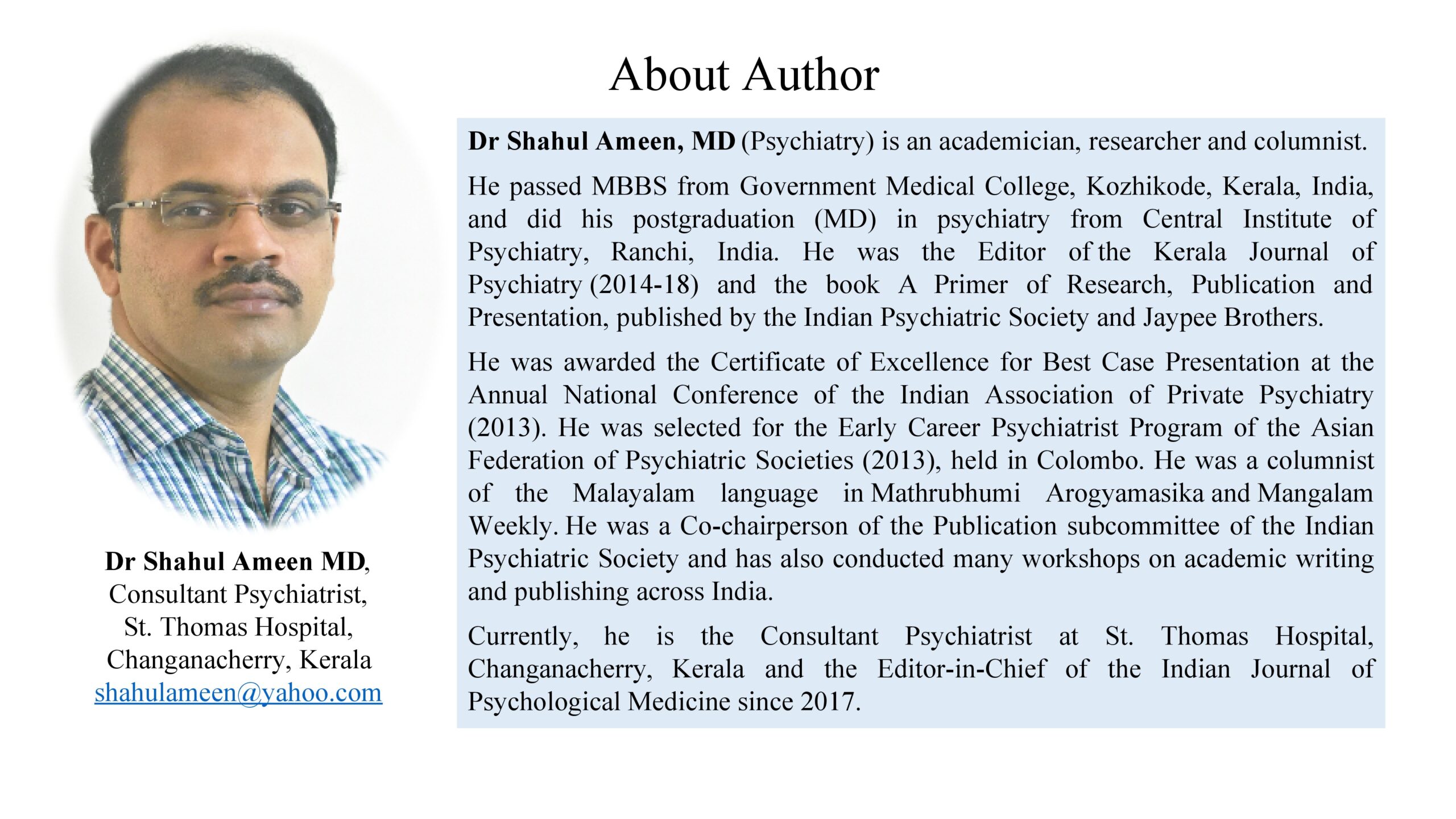Guest Editorial
Volume 12 Issues 8 August, 2022

Consultant Psychiatrist,
St. Thomas Hospital, Changanacherry, Kerala
shahulameen@yahoo.com
Many students and young faculty members regard medical journal editors villains: They compile boring, unreadable stuff and statistics into overpriced issues, heartlessly reject your works of love and hard labor with flimsy excuses, and then fill the journal pages with articles of their own or their cronies, right? I was the editor of the Kerala Journal of Psychiatry for four years and have been the editor of the Indian Journal of Psychological Medicine since 2017. Here, I describe the duties and responsibilities of a medical journal editor. I hope this will help shred some misconceptions and even inspire some of you, especially those with an aptitude for research and writing, to consider the option of becoming journal editors.
When you submit an article, the editor first ponders if it should be sent for peer review (i.e., evaluation by outside experts) or not. If the submission is not within the stated aims and scope of the journal, does not have the necessary scientific rigor, has ethical problems, or the quality of the language is abysmal, they may reject it outright without peer review. This is called desk rejection. Or they may ask you to change the article category — to a brief communication or letter to the editor, for example, or to convert some big tables, etc. to online-only supplementary material. They may make all such decisions independently or in consultation with the editorial team.
If the article is deemed to deserve peer review, they may do a plagiarism check. Before forwarding the manuscript to reviewers, they will also ensure that you have provided all necessary details and files. In journals that follow anonymized peer review, that is, the identities of the authors and their institution are hidden from the reviewers, the editor checks if any such clues are lurking in the pages. If any modifications need to be made by the authors (the process is called technical modification), the editors return the manuscript to them for the same. Subsequently, the editor sends the manuscript to 2-3 carefully chosen peer reviewers. Reviewers would usually be researchers who have published on the manuscript’s topic or those with expertise on the same. Reviewers are generally allowed 4-6 weeks to give their comments. Sometimes, reviewers may decline to do the review or not submit a review despite agreeing to do so. Then the editor may have to look for other experts, leading to unanticipated delays (and impatience in the authors!).
Once the reviews arrive, the editor appraises them and decides whether to reject the article or return it to the authors for revision. This is not based on a democratic process — i.e., by counting how many reviewers voted for acceptance or rejection. Instead, the editor considers the merits of the reviewers’ arguments in support of their recommendations. If a revision is allowed, and the authors submit a new draft, the editors may themselves make a decision on it or send the files back to the initial reviewers for opinions. After this stage, usually, a decision of acceptance or rejection is taken, or there may be more rounds of revisions. (By the way, believe it or not, rejecting is unpleasant for editors, too. But it is part of their mandate to fill the available number of journal pages with only the best submissions that come their way.)
Once they decide to accept an article, editors may perform its language editing and also some peer review of their own. To have sufficient expertise to do these effectively, some of them may have to go through appropriate books/courses on language and grammar on the one hand and research methodology and statistics on the other.
The accepted papers are then moved to the publisher. They will copyedit and properly format the article, design the PDF version, and email the file to both the editor and the authors. The editor would have to correct some errors here, too, especially in the formatting of headings and tables. Subsequently, once it is time to publish an issue as per the journal’s predetermined frequency, the editor has to tell the publisher which all accepted articles are to be included in that issue and in what order.
Many other tasks of editors are outside this process of manuscript flow. If someone submits a “fault-finding” letter on a published article, the editor forwards it to the authors of the related article for their responses. Editors may decide to publish supplement issues, apart from the regular issues, and summon appropriate guest editors for them. Editors must also work with the publishers to ensure the journal’s inclusion in major indexing agencies such as Scopus and MEDLINE.
Editors must develop and keep refining their team of associate, assistant, and section editors and peer reviewers. New members have to be included or promoted, and inactive and underperforming ones (secretly) expelled. At the end of a year, reviewers of that year may have to be sent a certificate, and their names listed in the first issue of the new year.
The editor must monitor the journal website and inform the publisher about any errors or required modifications. They have to also keep an eye on what kind of articles are getting most read, most cited, etc. As the journal grows, periodic updating may be needed to the instructions to authors, article categories, aims and scope, general editorial policies, the threshold for acceptance of articles, etc. Emails to reviewers and authors are usually based on templates, and editors may have to periodically modify them or create new ones.
In journals owned by professional organizations, editors must discuss major policy decisions with the organization’s executive committee. At the same time, they should practice, and if needed, even fight for, complete editorial independence on matters such as which articles get published.
Editors must follow high integrity and ethics and keep submissions-related matters confidential. They should keep themselves updated on the developments in the field of academic publishing, including technological advances and ethical guidelines. As an editor gains experience, they should share their expertise with and mentor budding researchers and aspiring editors and write articles, conduct workshops, etc., for the purpose.
Editors may also have to take care of the financial matters — including inviting advertisements, collecting payments and giving receipts for the same, safely keeping related documents like vouchers, motivating institutions and individuals to subscribe to the journal, getting the annual auditing done, etc.
The editor of a journal that is being started anew may have more responsibilities: including choosing a publisher, bargaining the financial aspects and other clauses with them, finalizing the journal’s name and website address, getting International Standard Serial Number (ISSN) and e-ISSN, getting registered with Registrar of Newspapers for India (RNI), drafting the author guidelines and aims and scope, begging around for an initial set of submissions, etc.
In small journals, like the Kerala Journal of Psychiatry that I used to edit, where there is no professional publisher involved, the editor would have to get the copyediting and designing of PDF files and webpages done by some agencies or do all that by themselves. They must also get the hard copies printed, packed, and sent to subscribers (if any!) and organization members as necessary. On the other hand, editors in highest-profile journals such as Nature and BMJ may have an entirely different workflow and set of headaches.
Being a journal editor is not an embellishment but a huge responsibility requiring diverse skills and a lot of hard work and time. (Yes, it would need 1-3 hours a day to edit a high-traffic journal, and you may have to sacrifice many T20 matches and OTT releases or the income from private practice or online consultations). Besides, in almost all cases, it is unpaid labor. However, as the “gatekeeper” of what your journal publishes, you are contributing to the quality of your field’s evidence base and helping young and inexperienced researchers get published and learn the nitty-gritty of research, academic writing, and publishing. This is a noble activity, especially in a country like India, where the quality of research and academic publishing is still suboptimal. I personally find the entire exercise highly psychologically rewarding.

